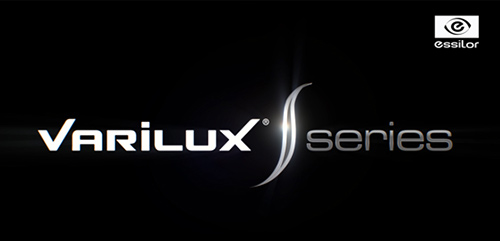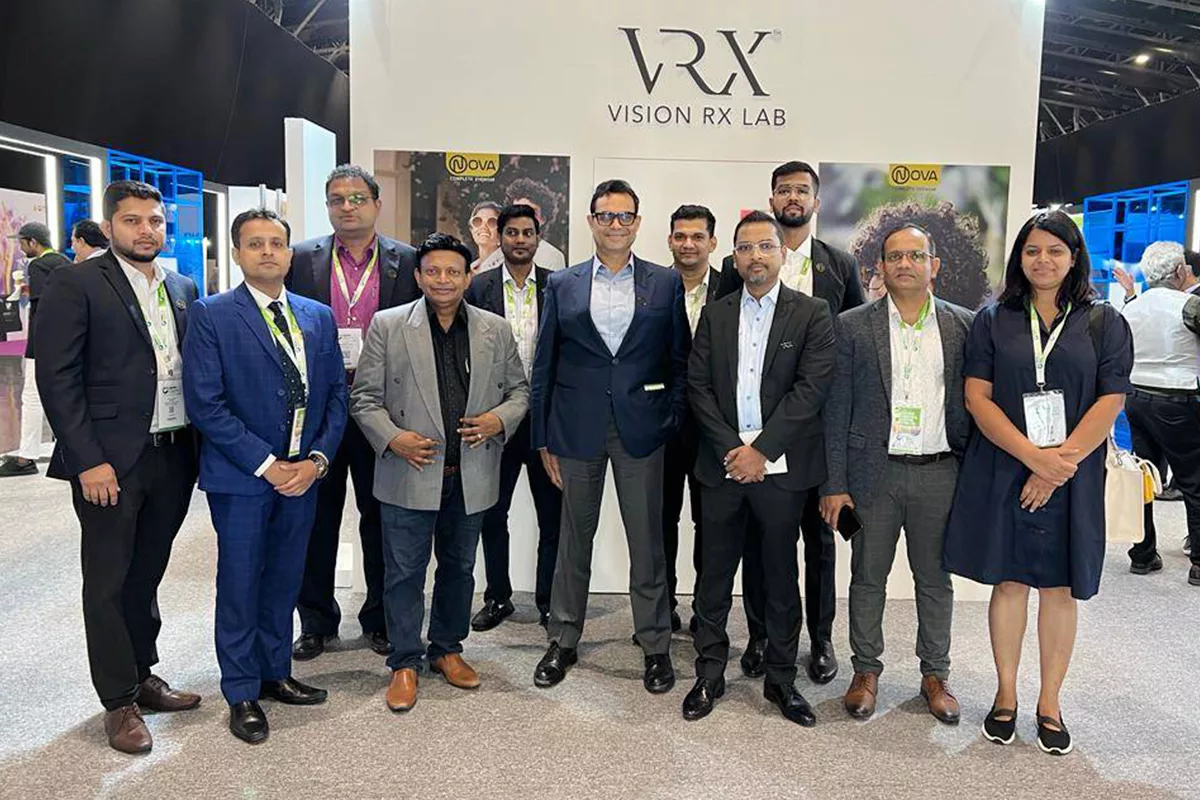A Revolutionary Approach to Fundamental Progressive Addition Lens Structure
Three groundbreaking technologies underlie the extraordinary benefits of new Varilux
S Series™ lenses:
- Nanoptix Technology™: A breakthrough technology that virtually eliminates “swim” compared to other premium progressive lenses. Nanoptix Technology™ reengineers the basic shape of the progressive lens by considering the lens as a set of many optical elements, allowing designers to minimize image deformation while maintaining the power progression.
- SynchronEyes Technology™: A powerful, innovative technology that integrates prescription data from both eyes into each lens, optimizing binocular visual fields and giving wearers expansive vision.
- 4D Technology™: A revolution in lens personalization that enhances overall visual response times by ensuring the sharpest vision in the leading dominant eye™. (Available only on Varilux S 4D™ lenses.)
This paper will introduce the contribution of Nanoptix Technology™ to the elimination of the “swim effect.”
Introduction
 All prior progressive lens designs have been limited by the need for tradeoffs and compromise. Before Nanoptix Technology™, for example, all design strategies that aimed to reduce “swim” had the unwanted side effect of narrowing the fields of clear vision. Progressive lenses could have either wide fields or reduced “swim”—but never both at the same time. This white paper will examine what causes “swim,” how it has been traditionally managed, and how the breakthrough Nanoptix Technology™ enables “swim” to be dramatically reduced without affecting other lens parameters.
All prior progressive lens designs have been limited by the need for tradeoffs and compromise. Before Nanoptix Technology™, for example, all design strategies that aimed to reduce “swim” had the unwanted side effect of narrowing the fields of clear vision. Progressive lenses could have either wide fields or reduced “swim”—but never both at the same time. This white paper will examine what causes “swim,” how it has been traditionally managed, and how the breakthrough Nanoptix Technology™ enables “swim” to be dramatically reduced without affecting other lens parameters.
“Swim” Defined By design, progressive lens curvature changes continuously from the distance to the near portion of the lens. This change in curvature provides a continuous increase in power to give presbyopic wearers clear vision at all distances. But this change in power at the lens surface also induces distortion that the wearer perceives as image deformation, making straight lines appear to be curved in the lower portion of the lens.1,2 In static vision—ie, when neither the wearer nor objects in the wearer’s environment are moving—the apparent curvature of a straight vertical line will be more pronounced when viewed through the lower than through the upper part of the progressive lens. This is the result of increasing prismatic deviation generated by the lens’ power gradient.
In dynamic vision, when the wearer and/or objects in the wearer’s visual field are in motion, the distortion effect is amplified, and the wearer may experience “swim,” as objects appear to move unnaturally in the visual environment.
Measuring “Swim”
 Up to now, some degree of the distortion that causes “swim” has been inherent in all standard progressive lenses due to the continuous power increase— and the resultant increase in prismatic deviation—from top to bottom of the lens. One can calculate the difference in horizontal displacement of a vertical line viewed through the top versus the bottom of a progressive lens. The value of this displacement, Δx, is a function of the difference in power between the two points on the lens and the lens’ shape.
Up to now, some degree of the distortion that causes “swim” has been inherent in all standard progressive lenses due to the continuous power increase— and the resultant increase in prismatic deviation—from top to bottom of the lens. One can calculate the difference in horizontal displacement of a vertical line viewed through the top versus the bottom of a progressive lens. The value of this displacement, Δx, is a function of the difference in power between the two points on the lens and the lens’ shape.
Dividing Δx by the maximum power variation, ΔP, yields a value, Δd, which is called the “end-to-end normalized deformation.” We can use this value as an objective predictor of “swim”: when Δd approaches zero in a progressive lens, as it does in a single vision lens, the “swim effect” is minimized.
The Effects of “Swim”
As noted, the progressive power variation induces image distortion in the lower part of the lens. This impacts peripheral vision, and when the observer is in motion, the effect is amplified. This is “swim”: the perception of unnatural movement of objects or the environment.
At its worst, “swim” can produce symptoms of motion sickness. The effect of visual distortion on postural stability has been demonstrated in an experiment conducted by Faubert and Allard.3 Using a virtual reality chamber to simulate a three-dimensional environment, they were able to create varying levels of dynamic distortion. While exposed to this environment, subjects’ posture was monitored by means of sensors on their heads and backs. Faubert and Allard found that postural instability increased with the amplitude of visual distortion.
Managing “Swim”: Past Efforts
As noted, “swim” has been an issue from the very first progressive lenses. To put Nanoptix Technology™ into perspective, it will help to see how greatly it differs from the way “swim” has traditionally been managed in progressive lenses.
Prentice’s Rule states that ray deviation increases with distance from the visual axis and with increasing lens power. Since lower power means less ray deviation, designers worked to reduce ray deviation by reducing power variation across the entire lens surface. This can be done by softening the lens design. Softening the design, however, also reduces fields of clear vision—an unwanted but unavoidable consequence.
Revolutionary Nanoptix Technology™
 Nanoptix Technology™ completely reengineers the lens calculation process. Using digital surfacing, Nanoptix Technology™ enables designers to take an entirely new approach to “swim.” In place of considering the entire lens surface as a continuous curve, Nanoptix Technology™ envisions the lens as many optical elements, each of which defines an optical path (Figure 1). The result is a revolutionary semi-finished progressive lens geometry that has never been seen before.
Nanoptix Technology™ completely reengineers the lens calculation process. Using digital surfacing, Nanoptix Technology™ enables designers to take an entirely new approach to “swim.” In place of considering the entire lens surface as a continuous curve, Nanoptix Technology™ envisions the lens as many optical elements, each of which defines an optical path (Figure 1). The result is a revolutionary semi-finished progressive lens geometry that has never been seen before.
When a Varilux S Series™ lens is calculated, the length and position of each optical element is optimized:
- Each element is first calculated to provide the required local optical design and power suitable for the given wearer and object distance.
- Each element is then individually modified to reduce the prismatic deviation that produces “swim.”
- The lens is then assembled element by element.
With Varilux S Series™ lenses, lens shape and power are managed at the individual element level, so that the degree of prismatic deviation can be controlled. Since it is differences in prismatic deviation that produce “swim,” stabilizing this deviation can greatly reduce “swim;” and this remains true even as add power increases.
A Perceptible Difference
 The Varilux. LiveOptics™ process allows optical designers to model and test concepts early on in the development process (Figure 2). In a virtual reality setting, the vision obtainable with a new lens concept can be accurately simulated, and patient acceptance of the optical effects can be determined immediately (Figure 3).
The Varilux. LiveOptics™ process allows optical designers to model and test concepts early on in the development process (Figure 2). In a virtual reality setting, the vision obtainable with a new lens concept can be accurately simulated, and patient acceptance of the optical effects can be determined immediately (Figure 3).
Using this technology, a randomized, single-blind trial compared the appearance of a grid in dynamic vision as it would look through traditional progressive lenses vs how it would appear with the same lens design but with Nanoptix Technology™ optimization. The difference with Nanoptix Technology™ was readily noticeable: By a margin of almost 3:1 (62% to 23%) subjects selected the dynamic vision with Nanoptix Technology™ optimization over standard progressive lens vision (Figure 4).
(In 15% of the choices, subjects had no preference.) This preliminary study demonstrated that by creating an innovative progressive lens geometry, Nanoptix Technology™ was able to reduce “swim” without disturbing the progressive power gradient.
Clinically Proven
 Although well-suited to proof-of concept testing, virtual reality cannot be a substitute for clinical trials with real lenses worn by typical patients in normal situations. Varilux. is committed to testing and retesting every new design through the LiveOptics™ process. To prove its value, a new lens design must be tested against a well-known standard, typically a best-in-class alternative. Thus, a clinical trial was performed to compare the Varilux S Series™ lens to the highly regarded Varilux Physio Enhanced™ lens.
Although well-suited to proof-of concept testing, virtual reality cannot be a substitute for clinical trials with real lenses worn by typical patients in normal situations. Varilux. is committed to testing and retesting every new design through the LiveOptics™ process. To prove its value, a new lens design must be tested against a well-known standard, typically a best-in-class alternative. Thus, a clinical trial was performed to compare the Varilux S Series™ lens to the highly regarded Varilux Physio Enhanced™ lens.
In the study reported here, 97 experienced progressive lens wearers were tested in a double-masked, randomized, controlled, crossover clinical trial. The distribution of refractive errors and reading adds in the study group closely approximated that of the general population of progressive lens wearers. The study group also paralleled the progressive lens-wearing population at large, with roughly equal numbers of hyperopes, myopes, and emmetropes, and 57% of the subjects having high adds vs 43% with low adds.
The test protocol called for a 1-week washout period, after which patients wore their first set of test lenses (either Varilux S Series™ or Varilux Physio Enhanced™) for 2 weeks, and then evaluated the lenses on a standardized questionnaire. The subjects then switched to the other lenses and wore them for 2 weeks. At the end of the second 2-week study period, subjects performed the same evaluation and stated whether they had a preference between the two lens types.
Strong Preference for Varilux S Series™
 Despite the lens used for comparison being the gold-standard Varilux Physio Enhanced™, patients showed a strong preference for the Varilux S Series™ lens with Nanoptix™ and SynchronEyes™ technologies. These wearers rated the Varilux S Series™ lenses higher on every parameter, including distance, near, and intermediate vision, dynamic vision, adaptation, and overall vision (Figure 5).
Despite the lens used for comparison being the gold-standard Varilux Physio Enhanced™, patients showed a strong preference for the Varilux S Series™ lens with Nanoptix™ and SynchronEyes™ technologies. These wearers rated the Varilux S Series™ lenses higher on every parameter, including distance, near, and intermediate vision, dynamic vision, adaptation, and overall vision (Figure 5).
Not surprisingly, wearers adapted readily to the lenses—61% adapted either “immediately” or “in a few minutes.” And the ratings for quality of dynamic vision—both with the wearer in motion and with the object in motion— were higher with Varilux S Series™ lenses.
This clinical trial proved that, with Nanoptix™ and SynchronEyes™ design technologies, the old limitations no longer hold, and, for the first time, patients can enjoy progressive lenses with wider fields and reduced “swim.” The concept proved in virtual reality testing was confirmed in a real-world clinical trial.
Conclusion: Limitless Vision™
Nanoptix Technology™ is a revolutionary design technology that provides stable progressive lens vision by dramatically reducing the “swim effect.” A result of increasing prismatic distortion induced by the progressive lens’ power gradient, “swim” affects dynamic vision, causing objects to appear to move unnaturally and creating a feeling of instability for the wearer.
Nanoptix Technology™ entirely reengineers the lens calculation process by envisioning the lens as many tiny optical elements. This enables the creation of a new and unprecedented lens geometry that allows lens designers to manage prismatic deviation at the element level.
The result is lenses with minimal difference in ray deviation across the progressive gradient. This reduces the level of distortion and virtually eliminates the “swim effect” compared to other premium progressive lenses.
Working with Nanoptix Technology™, SynchronEyes Technology™ coordinates and balances optical quality in both lenses so the eyes work together as one visual system. This breakthrough technology ensures expansive fields of clear vision. For wearers of the Varilux S Series™ lenses, the SynchronEyes™ and Nanoptix™ technologies work in concert to assure limitless vision™.
SynchronEyes Technology™: A Powerful, Innovative Approach to Binocular Vision in Progressive Addition Lenses
The second critical technology in Varilux S Series™ lenses is SynchronEyes™, the first technology ever to enhance binocular vision. The human visual system is binocular—in most people, vision is based on the simultaneous perception of images from two eyes.
Until now, however, progressive lenses have had to be designed monocularly—the lens design in one eye could not take into account vision in the other eye. The revolutionary SynchronEyes Technology™ breaks this paradigm, and for the first time lens design supports and optimizes binocular vision, allowing both eyes to work together as one visual system. The result is the widest, most expansive field of clear vision.
Binocular vision has three components. The most basic is simultaneous foveal perception, in which light is turned into neural signals sent from each retina to the visual cortex. Fusion within the cortex merges the two images into a single clear image that enables binocular summation. With binocular summation, the brain can process more information from the fused image than from either monocular image alone. Finally, in stereopsis, the visual system builds a three-dimensional representation from the pair of two-dimensional images.
Binocular summation is a key element in this process, and better binocular summation means better acuity, contrast sensitivity, color and shape perception, and greater ability to detect and discriminate between objects. Binocular summation is optimized when the optical quality of retinal images in the two eyes is as similar as possible—the ideal situation being identical (and low) aberration in each eye for each point of gaze.
SynchronEyes Technology™ makes this possible by using a mathematical construct—the cyclopean eye—to compare and balance aberrations at homologous points in the left and right lenses. (Homologous points are the two points—one on each lens—through which gaze is directed when both eyes are looking at the same point in space.) With SynchronEyes Technology™, the homologous retinal images are balanced with respect to optical quality, and binocular summation is optimized. This is true no matter the direction of gaze.
SynchronEyes Technology™ treats lenses as a pair, with each lens corrected to account for aberrations in the other. The result is balanced images, giving wearers the best possible binocular vision. By treating both eyes as one visual system, SynchronEyes Technology™ provides improved acuity and contrast sensitivity with edge-toedge expansive vision.
S Digital Surfacing Technology for Varilux S Series™ Lenses
Achieving the level of accuracy required to create the complex surface geometry of a lens designed with Nanoptix Technology™ demands precision in the digital surfacing process—especially in aligning the front surface with the back surface. With current digital surfacing, positioning errors can occur in lens blocking. While these are within acceptable tolerances for current-generation digitally surfaced lenses, Nanoptix Technology™ demands a higher level of manufacturing precision. To create lenses calculated with Nanoptix Technology™, the front and back surfaces of each element must be precisely positioned. Achieving this high level of precision surfacing requires a special process called S Digital Surfacing, which uses continuous closed-loop monitoring to ensure errorfree alignment of lens surfaces. This makes it possible to cut the front and back surfaces of the lens precisely in relation to each other, so the front surface of each element is precisely aligned with its back surface.
References 1. Le Grand Y. La distorsion en optique lunetterie. Annales d’optique oculaire. 1956 Jan. 2. Simonet P, Bourdoncle B, Miege C. Central and static distortion in ophthalmic lenses. Vision Science and its Application: OSA Technical Digest Series. 1995;1:31-4. 3. Faubert J, Allard R. Effect of visual distortion on postural balance in a full immersion stereoscopic environment. Proceedings of SPIE. 2004;5291:491-500.












